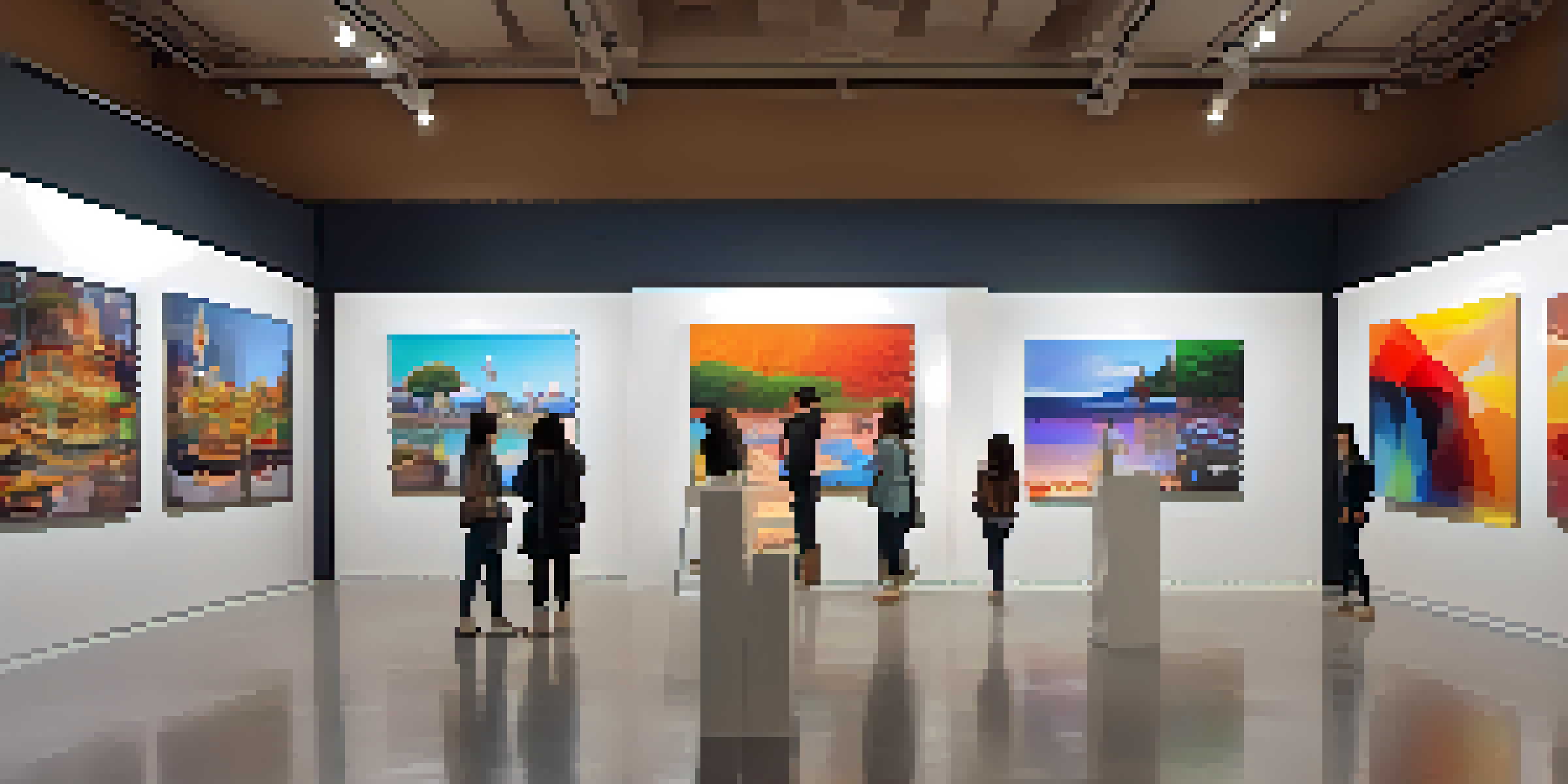Innovative Platforms for Selling Art: NFT Marketplaces Explored

What Are NFTs and Why They Matter in Art Sales
NFTs, or non-fungible tokens, are unique digital assets that represent ownership of a specific item, often artwork. Unlike cryptocurrencies, which are interchangeable, each NFT has distinct properties, making it one-of-a-kind. This uniqueness is what makes NFTs particularly appealing to artists and collectors alike, as they can prove ownership and authenticity in the digital realm.
Art is not freedom from discipline, but disciplined freedom.
In the art world, NFTs have opened up new avenues for creators to sell their work directly to consumers without relying on traditional galleries. This shift not only empowers artists but also allows them to receive a larger share of the profits. Imagine a painter being able to sell their art directly to a global audience without the restrictions of physical space—this is what NFTs offer.
Moreover, the ability to program royalties into NFTs means that artists can earn a percentage every time their work is resold. This ongoing financial incentive can help sustain an artist’s career in an industry that often struggles with fair compensation.
Popular NFT Marketplaces for Artists
There are several NFT marketplaces that have gained prominence among artists looking to sell their work. Platforms like OpenSea, Rarible, and Foundation provide a user-friendly interface where creators can mint, list, and sell their NFTs. Each platform has its unique features, catering to different types of artists and their audiences.

OpenSea, for instance, is one of the largest marketplaces and supports a wide variety of digital art and collectibles. Its vast user base allows artists to reach a broader audience. On the other hand, Foundation focuses on curating high-quality art and fosters a community-driven approach, making it a great choice for emerging artists.
NFTs Empower Artists in Sales
NFTs allow artists to sell their work directly to consumers, providing greater profits and control.
Rarible stands out because it allows users to create their own NFT marketplace, giving artists more control over their sales. This level of customization can be particularly appealing to those looking to build their own brand within the NFT space.
The Role of Community in NFT Art Sales
Community plays a vital role in the success of NFT art sales. Many artists find that engaging with their audience on social media platforms such as Twitter and Discord can significantly boost their visibility and sales. Building a loyal following often translates to more support when they launch new pieces on NFT marketplaces.
The greatest artist is not necessarily the one who creates the best work, but the one who connects with the audience.
By participating in community events, such as virtual exhibitions or collaborative projects, artists can establish themselves as active contributors within the NFT space. This engagement fosters connections that go beyond mere transactions, creating a supportive network of fans and fellow creators.
Additionally, many NFT marketplaces incorporate community features, allowing users to leave feedback and support one another. This sense of belonging can be incredibly motivating for artists, encouraging them to innovate and push their creative boundaries.
Challenges Faced by Artists in the NFT Space
While the NFT marketplace offers exciting opportunities, artists also face several challenges. The environmental impact of blockchain technology is a pressing concern, as the energy consumption of minting and trading NFTs can be substantial. Many artists are now seeking eco-friendly platforms that utilize sustainable practices.
Moreover, the volatility of cryptocurrency values can create uncertainty for artists looking to price their work. Art that sells for a significant amount today might be worth much less tomorrow due to market fluctuations. This unpredictability can make it difficult for artists to establish a stable income.
Community is Key in NFT Success
Engaging with audiences on social media and community events enhances visibility and support for artists.
Lastly, the sheer number of NFTs being created can lead to saturation in the market. Artists must find ways to differentiate their work and capture the attention of potential buyers amidst a growing sea of digital art.
How to Create and Mint Your First NFT
Creating and minting your first NFT can seem daunting, but it's relatively straightforward. First, you'll need to choose a blockchain, with Ethereum being the most popular option. After setting up a digital wallet, you can purchase some cryptocurrency to cover minting fees.
Next, select an NFT marketplace that aligns with your artistic vision. Most platforms offer step-by-step guides for minting your NFT, which typically involves uploading your artwork and adding relevant details, such as title and description. This process is akin to setting up an online store for your art, making it accessible to buyers around the world.
Once your NFT is minted, you can list it for sale or auction it off. Promoting your newly minted NFT through social media and community engagement is crucial to attracting potential buyers and showcasing your unique art.
The Future of Art Sales in the NFT Ecosystem
The future of art sales in the NFT ecosystem looks promising, with continuous growth and innovation on the horizon. As more artists and collectors embrace this technology, we can expect an evolution in how art is created, sold, and appreciated. The potential for virtual galleries and immersive experiences is just beginning to be tapped, which could redefine the art-viewing experience.
Moreover, as environmental concerns gain traction, we may see a rise in eco-conscious NFT platforms. Artists and collectors alike are increasingly advocating for sustainable practices, which could lead to the development of more energy-efficient blockchains.
Challenges in the NFT Market
Artists face issues like environmental impact, cryptocurrency volatility, and market saturation.
Overall, embracing the NFT revolution may allow artists to reach unprecedented audiences while establishing deeper connections with their fans. By adapting to this changing landscape, artists can carve out their unique space in the digital art world.
Conclusion: Embracing the NFT Movement
In conclusion, NFT marketplaces are reshaping the landscape of art sales, offering innovative solutions for artists and collectors alike. By understanding the dynamics of these platforms, artists can leverage the benefits of NFT technology to their advantage. The ability to connect directly with buyers and retain control over their work can lead to exciting new possibilities.
However, as with any new movement, it's essential for artists to navigate the challenges that come with it. From environmental concerns to market volatility, staying informed and adaptable will be key to thriving in this evolving space.

Ultimately, the NFT movement encourages artists to explore their creativity and find new ways to engage with their audience. By embracing this change, artists can not only secure their financial future but also contribute to a vibrant and diverse digital art community.